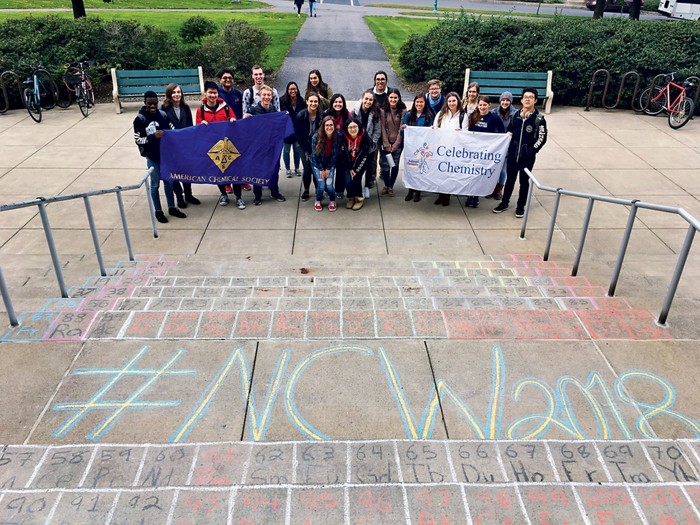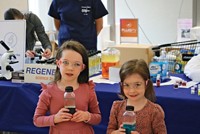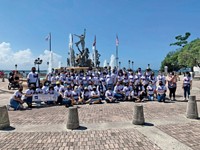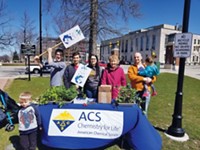Advertisement
Grab your lab coat. Let's get started
Welcome!
Welcome!
Create an account below to get 6 C&EN articles per month, receive newsletters and more - all free.
It seems this is your first time logging in online. Please enter the following information to continue.
As an ACS member you automatically get access to this site. All we need is few more details to create your reading experience.
Not you? Sign in with a different account.
Not you? Sign in with a different account.
ERROR 1
ERROR 1
ERROR 2
ERROR 2
ERROR 2
ERROR 2
ERROR 2
Password and Confirm password must match.
If you have an ACS member number, please enter it here so we can link this account to your membership. (optional)
ERROR 2
ACS values your privacy. By submitting your information, you are gaining access to C&EN and subscribing to our weekly newsletter. We use the information you provide to make your reading experience better, and we will never sell your data to third party members.
Programs
Highlights from National Chemistry Week 2018
Local sections celebrate all the ways that chemistry is out of this world
by Linda Wang
December 16, 2018
| A version of this story appeared in
Volume 96, Issue 49

What does chemistry look like in outer space? That was the big-picture question during this year’s National Chemistry Week (NCW), which celebrated the theme “Chemistry Is out of This World.”
The outreach campaign, organized annually by the American Chemical Society, took place Oct. 21–27 and focused on the chemistry of outer space. Volunteers from 169 of ACS’s 185 local sections around the US and Puerto Rico hosted hands-on activities and demonstrations at shopping malls, libraries, museums, and other public venues to communicate the value of chemistry in everyday life. More local sections participated this year than any year since 2008, and the in-person events had more than 75,000 participants.
“National Chemistry Week is an opportunity for the chemistry community to come together to share its passion for chemistry with the public around a unique theme,” says ACS president Peter K. Dorhout. “Whether in Kansas, the Bay Area, or Cape Cod, ACS members were involved with events that celebrated chemistry that’s out of this world.”
NCW was started in 1987 as National Chemistry Day by George Pimentel, who was ACS immediate past president at the time. The annual outreach program became so popular that in 1993, National Chemistry Day was renamed National Chemistry Week.
“The goal of National Chemistry Week is to engage the public, improve the perception of science among the public, and educate the public,” says Michael McGinnis, chair of the ACS Committee on Community Activities, which organizes NCW with the help of the ACS Office of Science Outreach. “We want to build the excitement for chemistry inside everyone, and I’m hoping that at some point it will capture somebody’s interest and they will say, ‘That’s what I want to do.’ ”
This year, more than 167,000 issues of the NCW publication Celebrating Chemistry were distributed to local section organizers to share with the public. And on Twitter, the NCW campaign had more than 25 million views. Many local sections planned trips for their members to a planetarium or a science museum as part of the NCW community event. In addition, students in grades K–12 were invited to participate in the NCW 2018 Illustrated Poem Contest (see the box on page 51 for the winners).
Through a National Science Foundation–funded project by ACS and the National Informal STEM Education Network, 33 ACS local sections were awarded an “Explore Science: Let’s Do Chemistry” kit that provided supplies and training to help sections and science centers across the country host a chemistry event for NCW.
McGinnis says NCW would not be what it is without the volunteers. “I wish I could thank every single volunteer individually,” he says. “I also hope that the volunteers learn something along with the participants of all the activities.”
The following, alphabetized by local section, are highlights from this year’s celebration, collected through reports from ACS local sections.
The Baton Rouge Local Section hosted Super Science Saturday at Louisiana State University’s Pete Maravich Assembly Center. More than 150 volunteers from local universities and industry engaged 750 kids in demonstrations at 19 activity stations.
The Binghamton Local Section organized a science café at the Kopernik Observatory and Science Center. The event included a short lecture on space chemistry, a demonstration of liquid nitrogen, 20 hands-on activities, and a telescope tour. Participants were served liquid-nitrogen ice cream and other snacks. The local section also held a Program-in-a-Box webinar event and a poem contest.
The California Section participated in the Bay Area Science Festival, with volunteers performing hands-on activities at North Bay Science Discovery Day and Discovery Day at AT&T Park. Activities included creating oxygen by splitting water and making ultraviolet-reactive beaded bracelets. Volunteers also gave out hundreds of pocket periodic tables and polled visitors on their favorite planet.
In the Central New Mexico Local Section, 385 high school students participated in a chemistry quiz game show. Other NCW activities included chemistry demonstrations, a research laboratory and campus tour, and career lectures.
The Central New York Section participated in the Zoo Boo event at Rosamond Gifford Zoo in Syracuse. More than 400 children engaged in hands-on activities, including making “boo” bubbles, making UV-reactive beaded bracelets, placing marshmallows in a vacuum, and splitting water.
Student affiliates from the Central Wisconsin Section hosted an ACS Program-in-a-Box event at the University of Wisconsin–Stevens Point. They also hosted hands-on activities and a planetarium show for families.
Volunteers from the Chemical Society of Washington conducted hands-on activities at the National Air and Space Museum in Washington, DC. More than 320 attendees engaged in eight hands-on activities, including building batteries with zinc and copper washers and launching rockets with citric acid and baking soda.

The East Central Illinois Local Section hosted a free planetarium tour and a talk by Brett McGuire, a visiting scientist from the National Radio Astronomy Observatory, about the chemistry of molecules found in interstellar matter. Local section volunteers also held demonstrations at a local library.
In the East Tennessee Local Section, University of Tennessee, Knoxville, professor Al Hazari presented his 28th annual chemistry show. Special guest Reggie Hudson, who works in the astrochemistry lab at NASA Goddard Space Flight Center in Greenbelt, Maryland, gave a seminar on his research. In addition, students from Pellissippi State Community College put on an ACS Program-in-a-Box event called Voyage to Mars.


The Erie Local Section held hands-on activities and demonstrations at Millcreek Mall. In addition, students from Gannon University put on an ACS Program-in-a-Box event.
The Green Mountain Local Section hosted two days of hands-on activities and chemistry magic shows in collaboration with the ECHO, Leahy Center for Lake Champlain in Burlington, Vermont. Student affiliate chapters from Saint Michael’s College and Norwich University participated in the events.
The Hawaii Local Section held an interactive hands-on exhibition day for more than 200 people at Kahala Mall in Honolulu. Exhibitors included companies, government agencies, and higher-education institutions from across Oahu.
The Indiana Local Section partnered with the Children’s Museum of Indianapolis to host 11 hands-on demonstrations. More than 100 volunteers participated in the event; each received a T-shirt designed by middle school students.
The Kalamazoo Section held its 32nd Chemistry Day event at the Kalamazoo Valley Museum. Despite the wintry weather, 60 volunteers presented 20 hands-on activities to more than 600 visitors to the museum. Volunteers from the local section also presented an ACS Program-in-a-Box event.
The Michigan State University Local Section engaged more than 950 visitors at the Impression 5 Science Center with activities such as making acid-base rockets, exploring craters on the moon, and making slime. Volunteers came from area high schools, as well as Olivet College and Michigan State University.
The Midland Section presented hands-on activities at the Dow Great Lakes Bay STEM Festival at Delta College, which was attended by more than 3,600 students and their families. The event was held over two days and was open to the public. The Mid-Michigan Technician Group, along with students from Delta College and the local astronomy club, hosted an ACS Program-in-a-Box at the Delta College Planetarium and Learning Center. The local section also partnered with the Midland Center for the Arts to put on activities at Family STEM Night.
The Montana Local Section distributed NCW kits at its fall social. It also held a poster session and an NCW exhibit. Volunteers distributed supplies for next year’s International Year of the Periodic Table to teachers and student groups.
The New York Section held its NCW event at the New York Hall of Science in Queens. More than 300 volunteers representing 22 colleges, high schools, nonprofit organizations, chemical companies, and business centers hosted hands-on activities and demonstrations that showcased the theme “Chemistry Is out of This World.”

The North Jersey Section hosted its 24th ChemExpo at Liberty Science Center. Approximately 250 volunteers from eight local colleges, three high schools, and several nonprofit organizations presented a variety of demonstrations on the theme “Chemistry Is out of This World.”
The Northeastern Section held outreach activities at the Museum of Science in Boston for more than 1,000 visitors. Highlights included two Phyllis A. Brauner Memorial Lectures presented by Bassam Z. Shakhashiri of the University of Wisconsin–Madison. The section hosted a second NCW event at the Boston Children’s Museum.
In the Northern New York Section, Dana Barry of Clarkson University presented a workshop about outer space to students at St. Mary’s School in Canton. Fifth- and sixth-grade students used a handmade diffraction grating to look at the light in their classrooms. After a discussion on the planets, students enjoyed a treat of astronaut ice cream.


The Orange County Section held hands-on activities at the Santa Ana Zoo. Attendees received free admission to the zoo, and volunteers included student affiliates from 12 college groups, local section members, and zoo staff.
In the Permian Basin Section, students from Midland College set up NCW activity tables at Midland Park Mall. More than 250 visitors to the mall engaged in activities such as learning about rocket reactions and how to make dry-ice bubbles.
The Princeton Section held its 19th NCW Activities Night at Frick Chemistry Laboratory at Princeton University. More than 500 kids and their families engaged in activities presented by 130 volunteers. Participants made models of molecules found in space, examined the properties of plasma, compared the spectra of pure gases, analyzed the spectrum of an unknown material and looked at the color and spectrum of a hot filament at different temperatures to find out how to take the temperature of a star.
Advertisement
In the Puget Sound Section, chemistry students and faculty from Skagit Valley College and the University of Washington visited the classrooms of more than 1,200 middle school students in Mount Vernon, Washington.
Volunteers from the Red River Valley Local Section made tie-dyed T-shirts focused on this year’s theme. The design featured a flask containing hydrothermal vents with heme molecules coming out from the flask.
The Richland Section hosted an ACS Program-in-a-Box event at Eastern Oregon University called Voyage to Mars. The section also hosted at Eastern Oregon University its 18th annual Girls in Science event, which attracted more than 100 sixth-through-eighth-grade girls from 18 schools.
The Salt Lake City Section celebrated this year’s theme with shooting rockets, glowing stars, misty planetary atmospheres, and slimy cave ooze. Participants also built batteries, tested water, and analyzed atmospheric pressure. Astronaut Scott “Doc” Horowitz talked about his space missions, answered questions about what it’s like in space, and autographed periodic tables.
The South Carolina Local Section held outreach activities for more than 300 people at the Soda City Market. Volunteers included local section members and graduate students. One local section member set up a solar telescope and a solar spectrograph for visitors to explore.
The South Florida Local Section sponsored outreach events at Fort Lauderdale’s Museum of Discovery and Science and the Phillip and Patricia Frost Museum of Science. More than 40 students and faculty from six universities and two high schools presented demonstrations and hands-on activities for around 2,000 children and adults.
The Southern Nevada Section partnered with the Discovery Children’s Museum in Las Vegas to host six hands-on activities. College students and local section members interacted with more than 80 kids during the event.
In the Susquehanna Valley Section, students from Bucknell University put on a Halloween Chemistry Show featuring a variety of Halloween-themed chemistry demonstrations. Students also decorated the front steps of Bucknell’s science building with the periodic table in chalk. Volunteers from the local section also hosted outreach activities at a local preschool and the Lewisburg Children’s Museum.

The Texas A&M Local Section held its annual Chemistry Open House at Texas A&M University for more than 1,200 visitors, who enjoyed a Chemistry Road Show, guided tours of active research laboratories, public talks from leading research scientists, and hands-on activities.
The Toledo Section hosted activity tables at STEM in the Park at Bowling Green State University, as well as STEM Night at Reynolds Elementary School and activities at Imagination Station Toledo. Hundreds of students and adults of all ages enjoyed activities such as studying molecules in motion and creating rocket reactions. In the Trenton Section, volunteers from the local section, Mercer County Community College, and Rider University engaged in hands-on activities with more than 700 elementary school children from seven schools and local Cub Scout troops.
The Upper Ohio Valley Local Section presented two chemistry magic shows at the Marietta College Chemistry Department. Approximately 50 students and their parents attended the shows, which lasted more than an hour each. Each student received a prize, along with ACS pencils, balloons, temporary tattoos, and stickers. The local section also hosted a Chemistry at the Mall event at Woodland Mall.
Planning for next year’s NCW celebration, which will take place Oct. 20–26, is already underway. The celebration during the International Year of the Periodic Table will focus on the properties and uses of metals, with the theme “Marvelous Metals.”
NCW Illustrated Poem Contest winners
The ACS Committee on Community Activities and the ACS Office of Science Outreach have announced the winners of the 2018 National Chemistry Week Illustrated Poem Contest, in which K–12 students were invited to share their interpretation of this year’s theme, “Chemistry Is out of This World,” in the form of illustrated poems. First-place winners in each grade category received $300. Second-place winners received $150.

First place: Rishi Khedekar, Princeton Local Section

Second place: Ren Aragaki, Hawaii Local Section

First place: Calliope Brennan, Binghamton Local Section

Second place: Isabella Ebach, Midland Local Section

First place: Ashmita Prajapati, Northeastern Local Section

Second place: Amelia Loshaw, Midland Local Section

First place: Abigail Feliciano, South Florida Local Section

Second place: Samantha Quartuccio, South Carolina Local Section





Join the conversation
Contact the reporter
Submit a Letter to the Editor for publication
Engage with us on Twitter